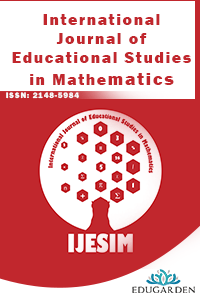Examining the Changes in Prospective Teachers’ Knowledge on Writing Story Problems
fractions, fraction operations, story problems, elementary mathematics
Examining the Changes in Prospective Teachers’ Knowledge on Writing Story Problems
fractions, fraction operations, story problems, elementary mathematics,
___
- Alexander, C. M., & Ambrose, R. C. (2010). Digesting Student-Authored Story Problems. Mathematics Teaching in the Middle School, 16(1), 27-33.
- Ann, S., Kulm, G. & Wu, Z. (2004). The Pedagogical content knowledge of middle school mathematics teachers in China and the U.S. Journal of Mathematics Teacher Education, 7, 145-172.
- Barlow, A. T., & Drake, J. M. (2008). Division by a fraction: Assessing understanding through problem writing. Mathematics Teaching in the Middle School, 13(6), 326-332.
- Cramer, K., & Whitney, S. (2010). Learning rational number concepts and skills in elementary school classrooms. Teaching and learning mathematics: Translating research for elementary school teachers, 15-22.
- Dixon, J. K., Andreasen, J. B., Avila, C. L., Bawatneh, Z., Deichert, D. L., Howse, T. D., & Turner, M. S. (2014). Redefining the whole: Common errors in elementary preservice teachers’ self-authored word problems for fraction subtraction. Investigations in Mathematics Learning, 7(1), 1-22.
- Ma, L. (2010). Knowing and teaching elementary mathematics: Teachers' understanding of fundamental mathematics in China and the United States. Routledge.
- McAllister, C. J., & Beaver, C. (2012). Identification of error types in preservice teachers' attempts to create fraction story problems for specified operations. School Science and Mathematics, 112(2), 88-98.
- National Mathematics Advisory Panel. (2008). Foundations for success: The final report of the National Mathematics Advisory Panel. Washington, DC: U.S. Department of Education.National Research Council, & Mathematics Learning Study Committee. (2001). Adding it up: Helping children learn mathematics. National Academies Press.
- Pirie, S. (2002). Problem posing: What can it tell us about students’ mathematical understanding? In D. Mewborn, P. Sztajn, E. White, H. Wiegel, R. Bryant & K. Nooney (Eds.), Psychology of Mathematics Education North America (PME-NA), Athens, GA (pp. 927–958, vol 1-4). Columbus, OH: Eric Clearinghouse for Science, Mathematics, and Environmental Education.
- Rittle-Johnson, B., & Koedinger, K. R. (2005). Designing knowledge scaffolds to support mathematical problem-solving. Cognition and Instruction, 23(3), 313-349.
- Rubenstein, R. N., & Thompson, D. R. (2001). Learning mathematical symbolism: Challenges and instructional strategies. The Mathematics Teacher, 94(4), 265.
- Yayın Aralığı: Yılda 4 Sayı
- Başlangıç: 2014
- Yayıncı: Ercan MASAL
A Comparative Analysis of Ratio and Proportion Problems in Libyan and Turkish Mathematics Textbooks
Awatef Ahmed KH ELAZZABİ, Ahmet Kaçar
Zeynep ÇAKMAK GÜREL, Muzaffer OKUR
Examining the Changes in Prospective Teachers’ Knowledge on Writing Story Problems
Nesrin SAHİN, James FETTERLY, Sirin BUDAK, Wesley MARTSCHİNG
